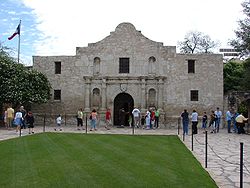Eugammon of Cyrene
Welcome to the Hispanic and Latino Americans portalHispanic and Latino Americans are Americans that have a Spanish or Latin American background, culture, or family origin. These demographics include all Americans who identify as Hispanic or Latino regardless of race. As of 2020, the Census Bureau estimated that there were almost 65.3 million Hispanics and Latinos living in the United States and its territories. "Origin" can be viewed as the ancestry, nationality group, lineage or country of birth of the person or the person's parents or ancestors before their arrival in the United States of America. People who identify as Hispanic or Latino may be of any race, because similarly to what occurred during the colonization and post-independence of the United States, Latin American countries had their populations made up of multiracial and monoracial descendants of settlers from the metropole of a European colonial empire (in the case of Latin American countries, Spanish and Portuguese settlers, unlike the Thirteen Colonies that will form the United States, which received settlers from the United Kingdom), in addition to these, there are also monoracial and multiracial descendants of Indigenous peoples of the Americas (Native Americans), descendants of African slaves brought to Latin America in the colonial era, and post-independence immigrants from Europe, the Middle East, and East Asia. As one of only two specifically designated categories of ethnicity in the United States, Hispanics and Latinos form a pan-ethnicity incorporating a diversity of inter-related cultural and linguistic heritages, the use of the Spanish and Portuguese languages being the most important of all. The largest national origin groups of Hispanic and Latino Americans in order of population size are: Mexican, Puerto Rican, Cuban, Salvadoran, Dominican, Brazilian, Colombian, Guatemalan, Honduran, Ecuadorian, Peruvian, Venezuelan and Nicaraguan. The predominant origin of regional Hispanic and Latino populations varies widely in different locations across the country. In 2012, Hispanic Americans were the second fastest-growing ethnic group by percentage growth in the United States after Asian Americans. (Full article...) Selected article Selected imageDid you know...
2011 Things you can do
Selected biography Mendez (birth name: Felicitas Gomez) was born in the town of Juncos in Puerto Rico. The Gomez family moved from Puerto Rico to Arizona. There they faced, and were subject to, the discrimination which was then-rampant throughout the United States. Mendez and her siblings were racialized as "black." (more...) SubcategoriesRelated PortalsAssociated WikiProjects
Hispanic and Latino American TopicsAfro-Latin American | Asian Hispanic and Latino Americans | Black Hispanic and Latino Americans | Californio | Chicano | Cuban American | Demographics of Hispanic and Latino Americans | Hispanic | Hispanic Americans in World War II | Hispanic and Latino Americans | Hispanic–Latino naming dispute | Hispanos | Latino | List of Hispanic and Latino Americans | MEChA | Mexican American | Puerto Rican people | Spanish language in the United States | Tejano | White Hispanic and Latino Americans Associated WikimediaThe following Wikimedia Foundation sister projects provide more on this subject:
Discover Wikipedia using portals
|

 Read
Read
 AUTHORPÆDIA is hosted by Authorpædia Foundation, Inc. a U.S. non-profit organization.
AUTHORPÆDIA is hosted by Authorpædia Foundation, Inc. a U.S. non-profit organization.






















